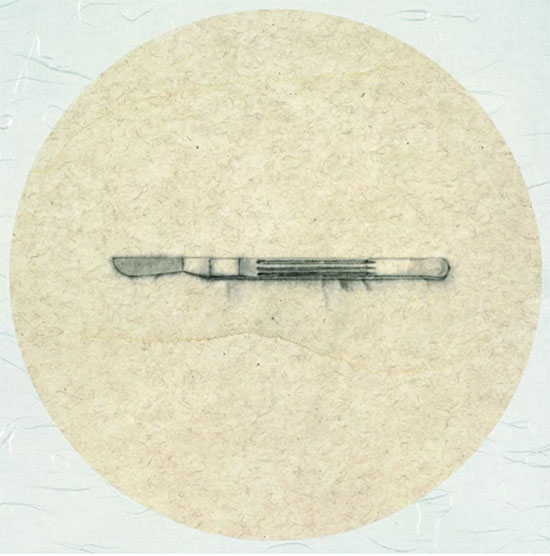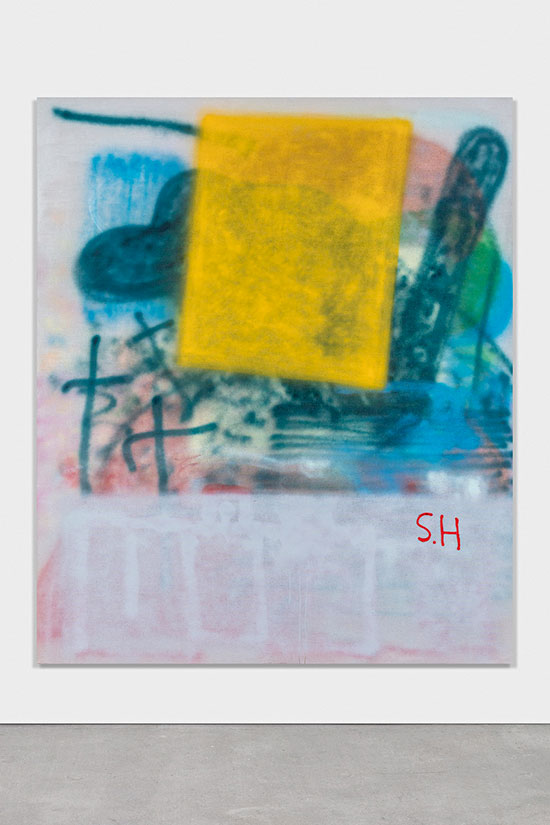Two roads diverged at Volta NY this year, and I took the one less traveled by. Parting ways with the raucous laughter in the crowded curated section of the fair—and granting that caricature has its place in art history—I avoided politics in preference for aesthetics.
The invitational fair of artist projects that emphasizes solo presentations, Volta has earned its reputation over the past decade for serious art drawn from an admirably global range of sources, exactly the strength displayed by the work in the five booths I believe ought not to be missed.
My choices range from luscious Abstract Expressionism coming out of India, Norway and Switzerland to the visual poetry of a photographer using Polaroids and a sophisticated installation by a mainland Chinese artist. The installation demonstrates that when it comes to political art or literature, those who work under Communism offer a valuable lesson in subtlety.
Zhang Yanzi at Ora-Ora (Hong Kong)
A suspended row of seemingly blood-stained surgical gauze bandages, tightly rolled and assembled meticulously on a beam, occupies the middle of the Ora-Ora installation, repelling many would-be visitors. The vivid red is actually a traditional ink pigment, bright as cinnabar and called zhusha, dissolved in water and stained into the white gauze, on which the artist has inscribed, in black calligraphy, fragments of a diary.
For those who have lived in China recently, choking on the world’s most notorious coal-produced pollution, the gauze invokes the frail barrier offered by masks against the toxins. On the wall, an antique delivery bed covered in delicately rendered paintings and calligraphy is titled Scar—as direct a connection between life and art as can be imagined.
Zhang is a superbly trained artist (in ink painting technique) who left her native Jiangsu province when she won admission to the rigorous Beijing Academy. The precision of her drawings of scalpel and stethoscope, watercolors assembled in a grid in the show, reflect her family background (her father was a veterinarian) and her own medical history: the long, arduous recovery from serious blood illness.
The artist had a recent exhibition at the Hong Kong Museum of Medical Sciences. Bei Dao, one of China’s great lyric poets and a master of solitude, has written in praise of Zhang’s “subtle balance between art and healing.”
.

"Registration (2)" by Zhang Yanzi, 2009 - 2013. Jute Paper, Ink and wash, 40 x 40 cm. Courtesy of Ora-Ora, Hong Kong.
.
Liliane Tomasko at Marc Straus (New York)
The sweeping gestures and fearless colors of Liliane Tomasko’s stunning paintings are the lure, but once I engaged with the work I found myself trying to unravel some of the skein of three-dimensional layers in the big, bold, recent Who you were is not what you will be. Does the band of cobalt blue that contains the swirling red and lemon yellow pass under or over some of the reds and whites? More lightly applied than at first appears, Tomasko’s acrylic and oil washes admit plenty of air, and she sweeps confidently across corners with a blast of spray paint that offer a revealing contrast, with their blurred edges, with the inter-woven tighter cuts of blue.
.

"Let me tie your laces" by Liliane Tomasko, 2017. Oil and Acrylic Spray on Canvas, 48 x 42 inches. Courtesy of Marc Straus Gallery.
.
Ken Tan, a partner at Marc Straus gallery in New York, helpfully points out that the later works are filling with a heavier load of information. Tomasko was born in Zurich, and is in important collections in Munich and Bern. She and her husband Sean Scully, another masterful painter in a very different mode, have had joint exhibitions at the Bancaja Cultural Center in Valencia, Spain.
Sandeep Mukherjee at Chimento Contemporary (Los Angeles)
It was not just the massive scale of the 10-part (each section 5 by 7 feet), immersive project Mutual Entanglements by Sandeep Mukherjee that wraps the viewer in its flowing tresses (like the giant weeds of the Sargasso Sea that can bring huge ships to a halt). It was the extraordinary virtuosity of the painting itself that was inescapable. The artist uses acrylic applied by brush, concrete broom, roller and spray bottle to big sheets of Duralene, a slick polymer film.
.

"Mutual Reentanglements 2" by Sandeep Mukherjee. Courtesy of Chimento Contemporary.
.
Mukherjee, who is originally from Puna, India but works in Los Angeles, says, “Painting becomes a chemistry set. Improvisation is key to the process which actively spatializes and temporalizes the body through its movements, activities and gestures.”
The Chimento Contemporary gallery built a downtown space just for the work, which stretched out runs for 50 feet, folded in a corner at the center. The saddest moment was when I learned that this may be its last iteration intact, as it is probably destined to be broken up into its ten parts, a great loss.
Susan Mikula at George Lawson Gallery (San Francisco)
The vague sense of a slow, unspoken narrative imbues the big atmospheric photographic works of Susan Mikula. With the soft blur of a Gerhard Richter photographic work, and the palette of a George Inness landscape (a diversity of greens that borders on the horticultural), the Kilo series interjects two young women into what appears to be an old house in some kind of sylvan environment surrounded by a hazy, low light.
.

"Kilo #28" by Susan Mikula, 2016. Framed chromogenic print from Polaroid original, cat. no. SUM089. Courtesy of George Lawson Gallery.
.
Mikula shoots with Polaroid, which is problematic in itself since the shelf life of the last batch of the now discontinued film supposedly expired in 2009. This flawed and fragile medium gives the works their poignancy, especially the still life in which neither of the figures appears. Blown up to large scale and printed on beautiful paper, they have some of the architectural intrigue that can be seen in the photographs of Deborah Turbeville.
Sebastian Helling at Kristin Hjellegjerde Gallery (London)
I cracked up when the ebullient Kristin Hjellegjerde called her star artist Sebastian Helling the “Rothko of Norway,” although I had to concede that the horizontal cloud of color at the base of one of his best paintings in the booth did have the AbEx master’s metaphysical aura.
Install a wild Norwegian graffiti artist in a London art studio with heavy metal music as accompaniment and the results are predictably fauvist. I enjoyed the high volume chromaticism and barely contained gestural vocabulary of some of Helling’s paintings, but then I could as easily trash one of the paintings as hopelessly self-indulgent.
While his graffiti art in Norway has sometimes been thought of as defacing property, in these pieces he’s been turned loose with aerosol and brushes and has brought a loose-limbed freedom to the canvases. I particularly enjoyed the floating geometry of a gold rectangle against broad blue swathes of action painting, vocalizing on top of power chords, even as I wish he had abstained from the graffiti culture’s obligation to tag everything with his initials right when the surface of the painting was shimmering with a certain delicacy. It is just that unpredictable abandon, unsociable and loud, that makes the work so intriguing.
In his statement in the press materials the artist makes no apology: “Layers of artistic languages overlap and deny each other. In the same spirit, my wish for communication (or anti-communication) is trapped within the relevance of the artwork.”
.

"No Destruction" by Sebastian Helling, 2017. Oil, acrylic and aerosol paint on canvas, 86 5/8 x 72 7/8 inches. Courtesy of Kristin Hjellegjerde Gallery.
.
_______________________________
BASIC FACTS: Volta Art Fair remains on view through March 5, 2017 at Pier 90, 51st Street and 12th Avenue. www.voltashow.com.
Hours: Wednesday 7 to 10 p.m., Thursday - Saturday noon to 8 p.m., Sunday, noon to 5 p.m.
Admission: $25 One-Day General Admission, $20 for Students, Cultural Institutions and Groups of 10 or more. The Public Vernissage is free.
________________________________
Copyright 2017 Hamptons Art Hub LLC. All rights reserved.

it’s Straus not Strauss my apologies for the typo
Kudo’s to Ken,Tim & Marc Straus gallery.